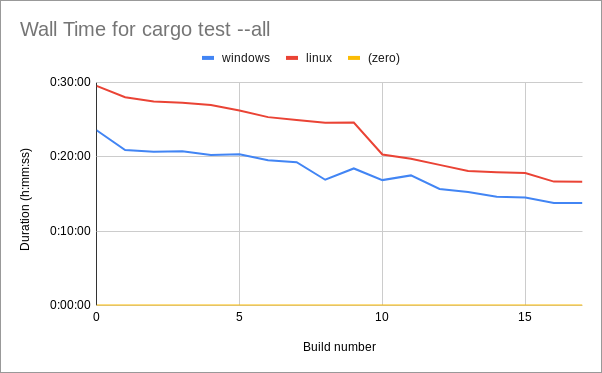Summary
In a 45k LOC / 102-crate workspace, moving tests from member crates into a single workspace_tests crate achieved the following improvements:
- Build and test duration in release mode reduced from 23 minutes to 13 minutes .
- Debug artifact disk usage reduced from
20 Gto7 G(65% reduction, fresh build), or230 Gto50 G(78% reduction, ongoing development)
Background
The rate of software development is affected by many limits. Two of these are:
- Hardware: Disk space, memory, CPU.
- Patience: How much one is willing to tolerate – wait times, software chores, spurious errors.
In building Will, these limits had been (b)reached. Money can’t buy patience, and there isn’t enough for more hardware 😛. So I did what every developer does when it takes too long to write software..
Write more software!
Method
Note: This method / advice is from Robert O’Callahan, credits to him.
Move module tests from each crate into a separate
workspace_testscrate.Tests from
a_crate/src/a_module.rsare moved toworkspace_tests/src/a_crate/a_module.rs.This does mean every type that normally isn’t
pubhas to be madepub.cargo test --all.
Results
Every 5~10 commits, I pushed to CI to get an incremental view of progress.
# Commit history
|\
| * e9e41425 Updated `CHANGELOG.md`.
| * 4f34d9cd Removed `dev-dependencies` from `ui_audio_model`.
| * 018ef48f Moved `ui_audio_loading` tests to `workspace_tests`.
| * c5d9feb4 Moved `tracker` tests to `workspace_tests`.
| * 881f34ee Moved `test_object_model` tests to `workspace_tests`.
| * 44464178 Moved `team_model` tests to `workspace_tests`.
| * 11a9f20d Moved `stdio_input` tests to `workspace_tests`.
| * fde2e158 Moved `stdio_command_stdio` tests to `workspace_tests`.
| * 814e5a9c Moved `sprite_model` tests to `workspace_tests`.
# .. elidedNote: Build number 10 is when Rust was upgraded from 1.36 to 1.37, which enabled pipelined crate compilation. Not sure why Windows dipped at build #8.
Compile and Test Durations
Linux 1 (2012 laptop):
Duration Before After Time Saved % Saved Speedup Compile 23m 47s12m 31s11m 16s47.4%1.9Test 5m 24s3m 29s1m 55s35.5%1.6Windows 1 (2016 laptop):
Duration Before After Time Saved % Saved Speedup Compile 20m 18s10m 38s9m 40s47.6%1.9Test1 3m 15s3m 8s0m 7s3.6%1.0Linux 2 (2019 laptop):
Duration Before After Time Saved % Saved Speedup Compile 3m 53s2m 50s1m 3s27.0%1.4Test 2m 27s2m 30s-0m 3s-2.0%1.0
► Hardware (click for details)
Linux 1 (2012 laptop):
- CPU: i7-3610QM @ 2.30 GHz (4 cores / 8 processors) – 4 threads2
- Memory: 8 GB
Windows 1 (2016 laptop):
- CPU: i7-6700 HQ (4 cores / 8 processors)
- Memory: 16 GB DDR4 2133 MHz
Linux 2 (2019 laptop):
- CPU: i7-9750H @ 2.60GHz (6 cores / 12 processors)
- Memory: 64 GB DDR4 2666 MHz
Disk Usage
Disk usage varies on CI vs local development – a development directory tends to keep previous artifacts lying around. The following table shows the improvement to disk usage before / after migration:
| Disk Usage | Before | After | Disk Saved |
|---|---|---|---|
| Clean Build | 20 G |
7 G |
13 G |
| Ongoing Development | 230 G |
50 G |
180 G |
Before:
// https://github.com/nushell/nushell
nushell> ls target/debug/ | where size > 100mb | pick name size | sort-by size | reverse
━━━━┯━━━━━━━━━━━━━━━━━━━━━━━━━━━━━━━━━━━━━━━━━━━━━━━━━━━━━━━━━┯━━━━━━━━━━
# │ name │ size
────┼─────────────────────────────────────────────────────────┼──────────
0 │ target/debug/will │ 388.5 MB
1 │ target/debug/game_play-ff48109c12a65823 │ 330.1 MB
2 │ target/debug/character_play-71862b5ed391b4a9 │ 298.0 MB
3 │ target/debug/sequence_play-d16d559316a09064 │ 296.7 MB
4 │ target/debug/game_input_stdio-03fdda36d5a48d2d │ 295.9 MB
// .. elided
62 │ target/debug/sprite_model-dca0d48bfeba7474 │ 107.5 MB
63 │ target/debug/map_model-20be732995dc914e │ 106.2 MB
━━━━┷━━━━━━━━━━━━━━━━━━━━━━━━━━━━━━━━━━━━━━━━━━━━━━━━━━━━━━━━━┷━━━━━━━━━━
After3:
nushell> ls target/debug/ | where size > 100mb | pick name size | sort-by size
━━━┯━━━━━━━━━━━━━━━━━━━━━━━━━━━━━━━━━━━━━━━━━━━━━━━━━┯━━━━━━━━━━
# │ name │ size
───┼─────────────────────────────────────────────────┼──────────
0 │ target/debug/assets_built_in-c6e394b4c4bc2bf2 │ 109.4 MB
1 │ target/debug/character_loading-fad1bc4c36f3147e │ 119.1 MB
2 │ target/debug/will │ 389.1 MB
3 │ target/debug/workspace_tests-5abfb3c4396f2427 │ 413.4 MB
━━━┷━━━━━━━━━━━━━━━━━━━━━━━━━━━━━━━━━━━━━━━━━━━━━━━━━┷━━━━━━━━━━
Takeaways
- Manually moving tests from 100 crates is somewhat tedious – to maintain crate structure, creating files / directories by hand takes time. It have been may be worth scripting.
- “Put all your tests in one crate” is still a trade off decision – need to expose non-API types and functions.
- Strict code organization helps a lot.
Future Work
There wasn’t much speed up for the test execution on the faster machines, as many tests are forced to run serially4. Many of these can be parallelized by not loading graphics in those tests (hint: easier with the ECS paradigm).
- Not measured using a
timecommand, but subtracted the compilation time from the total build duration. [return] - Only 4 processors used due to insufficient memory during linking –
cargo test --all -j 4. [return] assets_built_inandcharacter_loadingdon’t contain any tests, but they do uselazy_static, perhaps that’s causing the binary to be created, but I haven’t confirmed. [return]- On both Windows and Linux, the test binary segfaults when multiple threads interact with Vulkan through
rendy(haven’t figured out why) [return]
